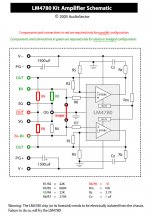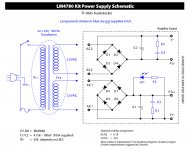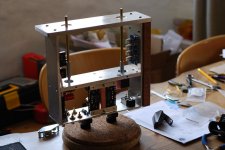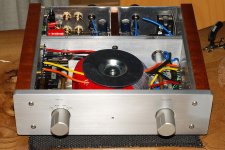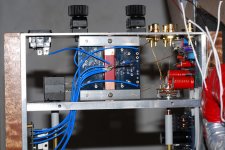1. I left the input series resistor off, using a piece of bare copper. What effect on the sound do people perceive when adding that R?
2. I'm interested in at least listening to the amp with a snubbed PS. I'm taking it that RZ and CZ on the amp board are the zobel. What are the correct values to use?
They also talk about an additional bypass C along with the series R-C snubber network. Where does this C mount and what is the correct value?
1. They perceive the coloration of resistor, if the circuit works you are not missing anything
2. Those additional parts have been specified in the schematic I include with LM4780 kit, this also applies to LM3875 kit. BTW, it has been posted on a first page of this thread.
Attachments
1. They perceive the coloration of resistor, if the circuit works you are not missing anything
2. Those additional parts have been specified in the schematic I include with LM4780 kit, this also applies to LM3875 kit. BTW, it has been posted on a first page of this thread.
Thanks Peter, I guess I missed that image.
I think I've gotten myself confused over the snubber-zobel issue.
The Image you posted of the rectifier board and the extra series RC is how I understood the snubber network.
At some point I started thinking that RZ and CZ on the amp board were the series RC in the snubber.
Is the zobel on the amp board part of the snubber?
If it is, does it replace the series RC on the rectifier board or do I need both?
If it's not, what is it's purpose?
Sorry for all the beginner questions. Thanks, Scott
Hi Peter,
Just assembled your LM3875 classic kit everything seems well and sounding nice .DC offset seems with in limits -7.3mv to -46.8mv / -33.8 to -73.3mv with a 50K RK27 pot
i have a bit of DC on the incoming source from my DAC what is the best option to block it
replace R1 with a 4.7uf cap Or Leave R1 and put a 4.7uf cap on the back of the input RCA ?
Is it better to use polarized or non polarized and what would the orientation be for polarized
A) with the + towards the incoming signal from the DAC
B) - towards the incoming signal from the DAC
any suggestions for particular flavour cap ?
Many thanks in advance
Koog
Just assembled your LM3875 classic kit everything seems well and sounding nice .DC offset seems with in limits -7.3mv to -46.8mv / -33.8 to -73.3mv with a 50K RK27 pot
i have a bit of DC on the incoming source from my DAC what is the best option to block it
replace R1 with a 4.7uf cap Or Leave R1 and put a 4.7uf cap on the back of the input RCA ?
Is it better to use polarized or non polarized and what would the orientation be for polarized
A) with the + towards the incoming signal from the DAC
B) - towards the incoming signal from the DAC
any suggestions for particular flavour cap ?
Many thanks in advance
Koog
the reverse recovery spike for an ultrafast diode will be much smaller and faster than with a normal recovery diode, and hence more easily damped with a snubber. I generally use whatever ultrafast diodes I have on hand, and damp them with a combination of ferrite beads and RC snubbers.
I found this in a 6 year old thread on chip amp diodes. What is the current consensus on the best possible diode in this application? Peter, do you still believe that although MUR860 is best in a ship amp, a different diode is best in a DAC circuit? What about in an active XO?
I found this in a 6 year old thread on chip amp diodes. What is the current consensus on the best possible diode in this application? Peter, do you still believe that although MUR860 is best in a ship amp, a different diode is best in a DAC circuit? What about in an active XO?
I use MUR860 in all analog circuits. With digital I prefer MSR860.
with a 50K RK27 pot
i have a bit of DC on the incoming source from my DAC what is the best option to block it
replace R1 with a 4.7uf cap Or Leave R1 and put a 4.7uf cap on the back of the input RCA ?
Is it better to use polarized or non polarized and what would the orientation be for polarized
A) with the + towards the incoming signal from the DAC
B) - towards the incoming signal from the DAC
any suggestions for particular flavour cap ?
I would replace R1 with small cap (4.7-10uF). BG N would be my preferred choice, but if not available try any other electrolytic (Rubycon Z series, Elna Silmics etc); + towards the incoming signal
Is the zobel on the amp board part of the snubber?
If it is, does it replace the series RC on the rectifier board or do I need both?
If it's not, what is it's purpose?
Zobel is separate circuit from a snubber.
You can read about Zobel here: IC Audio Power Amplifiers and Zobel Networks: One Size Does Not Fit All | Digital Home DesignLine
Snubber was introduced to chip amps by CarlosFM, in order to make large PS filter caps more "friendly"
I don't use any of them in my amps.
I just finished integrated stereo LM3875 with built in NOS DAC (both premium kits) and am listening to the sound they make while writing this.
I am being patient before judging the sound until they are fully burned in and settled but some things are pretty obvious.
Very open, fast, and as real as any amp I have ever heard - at any price. I am used to a SET but this offers something else. I can perceive more micro detail, more subtlety but with added gusto and it all adds up to a greater sense of space ..more palpable. Isn't that what hifi is about?
Anyway I wanted to thank Peter for his support over the last few weeks via email. I have not wanted to ask all of my newbie questions and fill up the thread with what to others may be obvious stuff and Peter has helped me through the build like a true gentleman.
If anyone is sitting on the fence and wondering if it is worth it I can assure anyone that this really is something special.
THANK YOU PETER
I am being patient before judging the sound until they are fully burned in and settled but some things are pretty obvious.
Very open, fast, and as real as any amp I have ever heard - at any price. I am used to a SET but this offers something else. I can perceive more micro detail, more subtlety but with added gusto and it all adds up to a greater sense of space ..more palpable. Isn't that what hifi is about?
Anyway I wanted to thank Peter for his support over the last few weeks via email. I have not wanted to ask all of my newbie questions and fill up the thread with what to others may be obvious stuff and Peter has helped me through the build like a true gentleman.
If anyone is sitting on the fence and wondering if it is worth it I can assure anyone that this really is something special.
THANK YOU PETER
Another happy customer
Pics of finished amp made using LM3875 premium kit (also build DAC into same chassis)
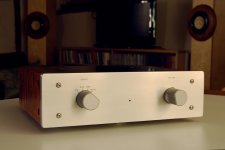
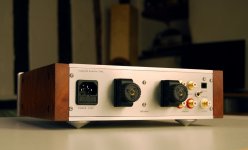
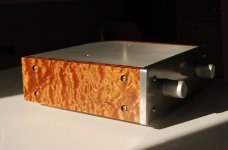
These things sound amazing. Breathtakingly good. No hyped detail just a rare mix of subtle delicacy and fast heavy punch. The DAC's bass weight through this amp is awesome. It registers as low as I can hear. I cannot imagine how things can be improved from here. Still, if it really can, I guess Peter is working on it
Thank you Peter for all your help
Pics of finished amp made using LM3875 premium kit (also build DAC into same chassis)



These things sound amazing. Breathtakingly good. No hyped detail just a rare mix of subtle delicacy and fast heavy punch. The DAC's bass weight through this amp is awesome. It registers as low as I can hear. I cannot imagine how things can be improved from here. Still, if it really can, I guess Peter is working on it
Thank you Peter for all your help

Pics of finished amp made using LM3875 premium kit (also build DAC into same chassis)
very nice indeed Martin any chance of some close ups inside
koogar
Rodmunch
Lettering is wet slide transfers. I bought them here in the UK (normally supplied to the model railway folks). I couldn't source any Letraset with a font and size I wanted. These are 2mm.
A bit of a fiddle to apply. You need to have a gloss finish (no brushed bare metal) so I have to apply lacquer. Each letter has to be soaked in water and applied individually. Once dried you can apply the next one! I worked on bits of words all over the amp until the first one was dry. Then you need to apply lacquer after to protect.
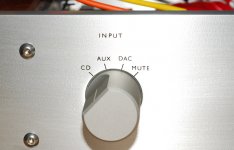
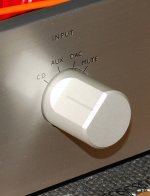
Looks OK in most lighting conditions but under close examination you can still see the glue transfer sheet. (I am very particular so this bugs me...but hey, I listen in the dark most of the time!)
Rear took some time...
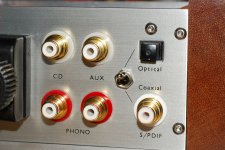
Lettering is wet slide transfers. I bought them here in the UK (normally supplied to the model railway folks). I couldn't source any Letraset with a font and size I wanted. These are 2mm.
A bit of a fiddle to apply. You need to have a gloss finish (no brushed bare metal) so I have to apply lacquer. Each letter has to be soaked in water and applied individually. Once dried you can apply the next one! I worked on bits of words all over the amp until the first one was dry. Then you need to apply lacquer after to protect.


Looks OK in most lighting conditions but under close examination you can still see the glue transfer sheet. (I am very particular so this bugs me...but hey, I listen in the dark most of the time!)
Rear took some time...

- Home
- More Vendors...
- Audio Sector
- Commercial Gainclone kit- building instructions
